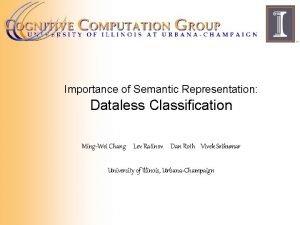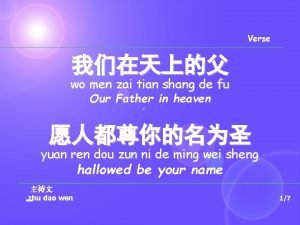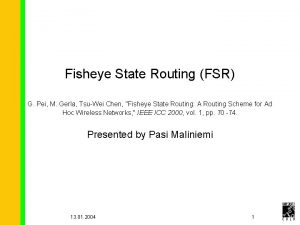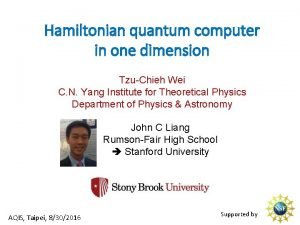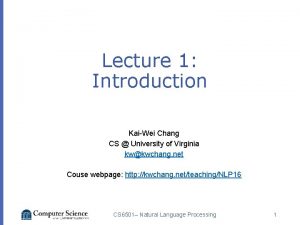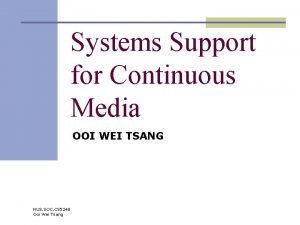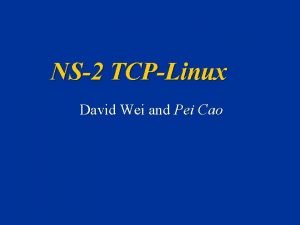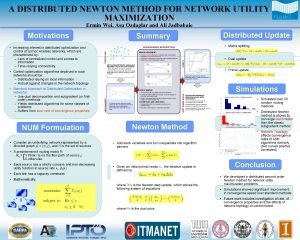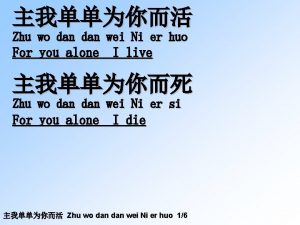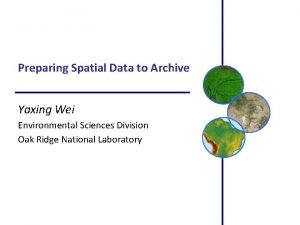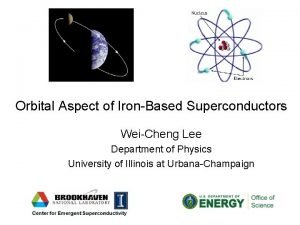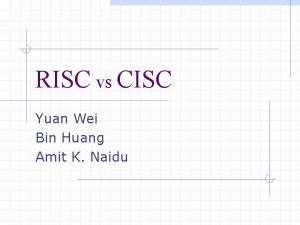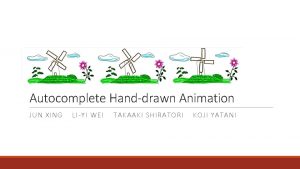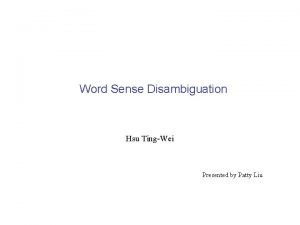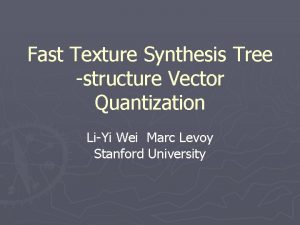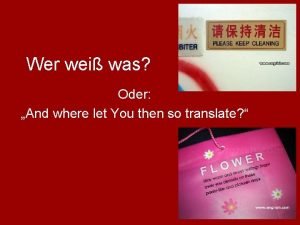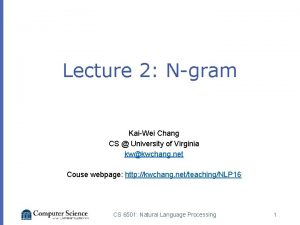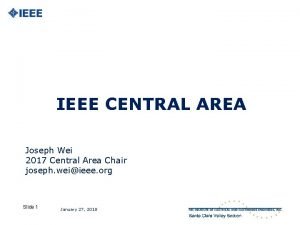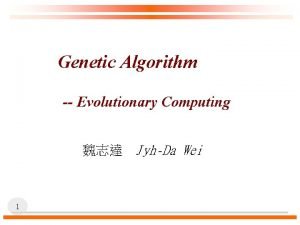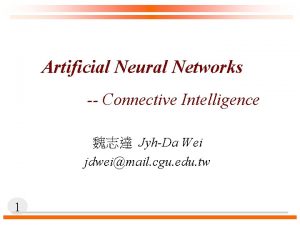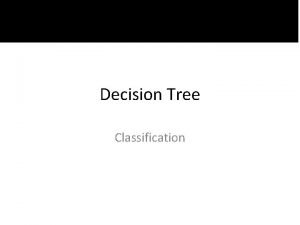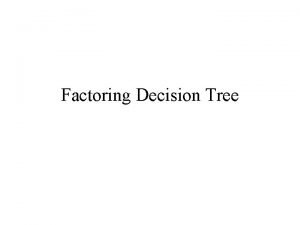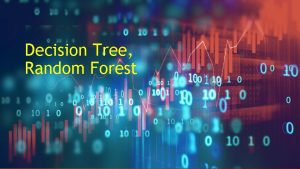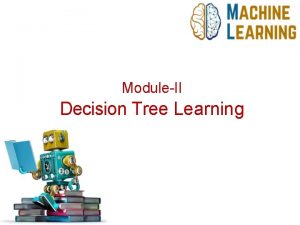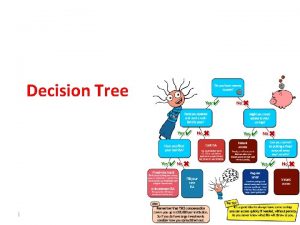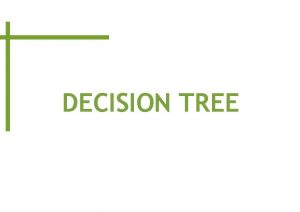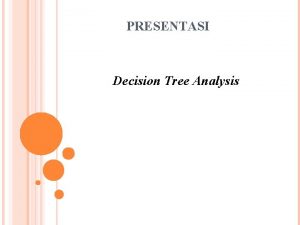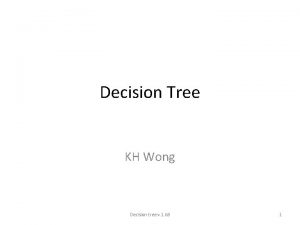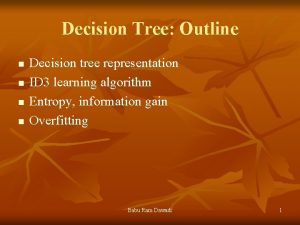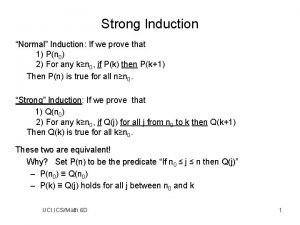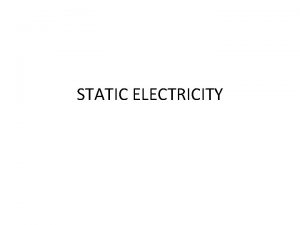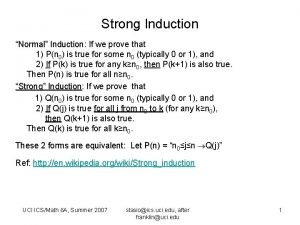Decision Tree JyhDa Wei 1 Induction of Decision

































- Slides: 33

Decision Tree 魏志達 Jyh-Da Wei 1

Induction of Decision Tree (1) Attributes = {Outlook, Temperature, Humidity, Wind} Play. Tennis = {yes, no} Outlook sunny rain Humidity high no 2 1. Why not Humidity? overcast Wind no normal yes strong no weak yes 2. For what?


attr 1 attr 2 attr 3 … result 樣本空間 (sample space) 機率事件= {yes, no} 或 {A勝, B勝, 合局} (Random variable Event) Decision Tree = 切割樣本空間(使它越來越不亂) (1) Self-Information (事件) (2) Entropy (樣本空間) 4

Self-information log 2(1/pi) = - log 2(Pi) 5 壹電視主播蕭彤雯






Example (m=2) h=I(S)= f(p)= p p 1=1, p 2=0 – Entropy h = 0 f(p) p p 1=p 2=1/2 – Entropy h = 1 11

Example (m=4) p p 1=1, p 2=p 3=p 4=0 – Entropy h = 0 p p 1=p 2=1/2, p 3=p 4=0 – Entropy h = 1 p p 1=p 2=p 3=p 4=1/4 – Entropy h = 2 Think: 決策樹的最後分支該有什麼特質? 能否讓這個特質與最後分支提早出現? 12


Entropy and Information Gain p p S contains si tuples of class Ci for i = {1, …, m} Information measures info required to classify any arbitrary tuple m=3: {A勝, B勝, 合局} p Entropy of attribute A with values {a 1, a 2, …, av} v=3: {台南, 洲際, 新莊} p p 14 Information gained by branching on attribute A (越大越好)


16



p Break 19

Example II : Scholarship Owners Candidate relation for Target class: Scholarship owner ( =120) Note: 最高會有 2 x 3 x 2 x 2 x 3=72 細項組合, 但有些組合沒出現實例 20 Candidate relation for Contrasting class: Other students ( =130)

Scholarship Owners (1) Classes: m=2 A={“Science”, “Engineering”, “Business”} I(s 1, s 2)=0. 9988 120 “Science”“Engineering” “Business” 0. 9183 21 0. 9892 130 E(A)= 0 84 42 36 46 0 42 Y N Y N 126/250 Iscience + 82/250 Iengineering+ 42/250 Ibusiness =0. 7873

Scholarship Owners (2). Relevance analysis – Calculate expected info required to classify an arbitrary tuple – Calculate entropy of each attribute: e. g. major # scholarship owners in “Science” 22 Number of other students in “Science”

Scholarship Owners (3) Calculate expected info required to classify a given sample if S is partitioned according to the attribute Calculate information gain for each attribute – Information gain for all attributes 23

Scholarship Owners (4) 4. Initial working relation (W 0) derivation – R = 0. 1 亦可設定閥值篩選留下強的屬性,不完整建立 D 3 – remove irrelevant/weakly relevant attributes from candidate relation => drop gender, birth_country – remove contrasting class candidate relation 5. 但若要建立完整D 3, 每個分支後的子樹要各自 24 重新統計, 而採用各自最佳的後續分支策略。


Agglomerative Clustering p p Start with N groups each with one instance and merge two closest groups at each iteration Distance between two groups Gi and Gj: – Single-link: – Complete-link: – Average-link, centroid 26 族群之間的距離有三式可選用

27

attr 1 attr 2 attr 3 … result 樣本空間 (sample space) 分類= {yes, no} 或 {A勝, B勝, 合局} 如果各項量測值是連續值 attr 1, attr 2, …are continuous value? 28

Recursive Partitioning Choose the split that reduces impurity the most p Split points become nodes on the tree p – Attribute – Threshold 29

Attribute and Threshold p Split points become nodes on the tree – Attribute – Threshold p Derived attribute – e. g. w/h 30

Cut on the Same Attribute? ? 31

Cross Validation and Tree Pruning Unseen data Training data (# splits) 32 未完成分割的subset, 以多數決進行決策

Random Forest (RF) p Leo Breiman, 2001 p Random resampling (Bootstrapping) p Not requiring cross validation p Decision by Voting 33
 Classification by decision tree induction
Classification by decision tree induction Objectives of decision making
Objectives of decision making Dividend decision in financial management
Dividend decision in financial management Decision tree and decision table examples
Decision tree and decision table examples Liyi wei
Liyi wei Ming-wei chang
Ming-wei chang Sheng wei moffitt
Sheng wei moffitt Pregiera padre nostro
Pregiera padre nostro Roger clemmons dvm
Roger clemmons dvm Pei wei polaris
Pei wei polaris Tzu chieh wei
Tzu chieh wei Shen, wei-min
Shen, wei-min Kaiwei chang
Kaiwei chang Chua wei yang
Chua wei yang Pollub organizacja roku
Pollub organizacja roku Ooi wei tsang
Ooi wei tsang Cao linux
Cao linux Jim wei
Jim wei Ermin wei
Ermin wei Yichen wei
Yichen wei 魏立一
魏立一 Wei ni er huo
Wei ni er huo Yaxing wei
Yaxing wei Wei cheng lee
Wei cheng lee Wei pollub
Wei pollub Zhewei wei
Zhewei wei Wei bin
Wei bin Li-yi wei
Li-yi wei Ting wei ya meaning
Ting wei ya meaning Liyi wei
Liyi wei Let wei
Let wei Wong koh wei
Wong koh wei Kaiwei chang
Kaiwei chang Joseph wei
Joseph wei





